Plantar Fasciitis 101
 Plantar fasciitis is caused when the arch of the foot becomes inflamed. Each step that a person with the condition takes aggravates the plantar-fascia tissue, making it even more difficult to heal. Plantar fasciitis is the most common foot condition seen by podiatrists. People who are active and always on their feet are likely candidates for the condition. Most people find treatment through over-the-counter medications. However, if your pain persists, you should see a podiatrist
Plantar fasciitis is caused when the arch of the foot becomes inflamed. Each step that a person with the condition takes aggravates the plantar-fascia tissue, making it even more difficult to heal. Plantar fasciitis is the most common foot condition seen by podiatrists. People who are active and always on their feet are likely candidates for the condition. Most people find treatment through over-the-counter medications. However, if your pain persists, you should see a podiatrist
Plantar fasciitis can be very painful and inconvenient. If you are experiencing heel pain or symptoms of plantar fasciitis contact Dr. Steven Shlonsky of Kentucky. Dr. Shlonsky can provide the care you need to keep your pain free and on your feet.
What is Plantar Fasciitis?
Plantar fasciitis is the inflammation of the thick band of tissue that runs along the bottom of your foot, known as the plantar fascia, and causes mild to severe heel pain.
What Causes Plantar Fasciitis?
· Excessive running
· Non-supportive shoes
· Overpronation
· Repeated stretching and tearing of the plantar fascia
How Can It Be Treated?
· Conservative measures – anti-inflammatories, ice packs, stretching exercises, physical therapy, orthotic devices
· Shockwave therapy – sound waves are sent to the affected area to facilitate healing and are usually used for chronic cases of plantar fasciitis
· Surgery – usually only used as a last resort when all else fails. The plantar fascia can be surgically detached from the heel
While very treatable, plantar fasciitis is definitely not something that should be ignored. Especially in severe cases, speaking to your doctor right away is highly recommended to avoid complications and severe heel pain. Your podiatrist can work with you to provide the appropriate treatment options tailored to your condition.
If you have any questions please feel free to contact our office located in Louisville, KY. We offer the newest diagnostic tools and technology to treat your foot and ankle needs.
How to Care for Arthritic Feet
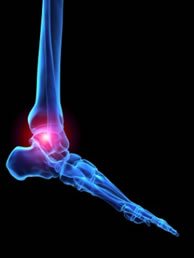 According to recent research, what you incorporate in your diet can affect your arthritis inflammation symptoms. “The goal of your diet should be to eat foods that have been shown to reduce inflammation, which can help manage symptoms like joint pain, swelling, and tenderness,” says registered dietitian nutritionist Kim Larson. Foods such as fatty fish or omega-3 fish oils, fruits and vegetables, turmeric, and ginger can help alleviate inflammation. However, Larson suggests cutting back on red meat, carbohydrates, and sugar.
According to recent research, what you incorporate in your diet can affect your arthritis inflammation symptoms. “The goal of your diet should be to eat foods that have been shown to reduce inflammation, which can help manage symptoms like joint pain, swelling, and tenderness,” says registered dietitian nutritionist Kim Larson. Foods such as fatty fish or omega-3 fish oils, fruits and vegetables, turmeric, and ginger can help alleviate inflammation. However, Larson suggests cutting back on red meat, carbohydrates, and sugar.
Arthritis can be a difficult condition to live with. If you are seeking treatment, contact Dr. Steven Shlonsky of Kentucky. Dr. Shlonsky can provide the care you need to keep you pain-free and on your feet.
Arthritic Foot Care
Arthritis is a joint disorder that involves inflammation of different joints in your body, such as in your feet. Arthritis is often caused by a degenerative joint disease and causes mild to severe pain in all affected areas. On top of this, swelling and stiffness in the affected joints can also be a common symptom of arthritis.
In many cases, wearing ill-fitting shoes can worsen the effects and pain of arthritis. Wearing shoes that have a lower heel and extra room can help your feet feel more comfortable. In cases of rheumatoid arthritis, the arch in your foot may become problematic. Buying shoes with proper arch support that contour to your feet can help immensely.
Alleviating Arthritic Pain
- Exercises that stretch the foot can prevent further pain and injury and increase mobility
- Most of the pain can be alleviated with anti-inflammatory drugs, heat, and topical medications
- Massages can help to temporarily alleviate pain.
It is best to see your doctor for the treatment that is right for your needs and symptoms. Conditions vary, and a podiatrist can help you determine the right method of care for your feet.
If you have any questions please feel free to contact our office located in Louisville, KY. We offer the newest diagnostic and treatment technologies for all your foot and ankle needs.
Aaron Mound Breaks Toe
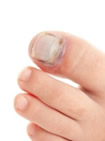 Aaron Mound of Real Salt Lake has suffered a broken toe injury that has kept him off the field for four to eight weeks. Although there had been a lot of speculation over what had kept him out for so long, the injury was recently confirmed by beat writer, Aaron Falk. Mound is currently deciding whether or not he wants to have his toe surgically repaired. Deciding to have the surgery would prevent him from returning to the field in 2016.
Aaron Mound of Real Salt Lake has suffered a broken toe injury that has kept him off the field for four to eight weeks. Although there had been a lot of speculation over what had kept him out for so long, the injury was recently confirmed by beat writer, Aaron Falk. Mound is currently deciding whether or not he wants to have his toe surgically repaired. Deciding to have the surgery would prevent him from returning to the field in 2016.
A broken toe can be very painful and lead to complications if not properly fixed. If you have any concerns about your feet, contact Dr. Steven Shlonsky of Kentucky. Dr. Shlonsky will treat your foot and ankle needs.
What to Know About a Broken Toe
Although most people try to avoid foot trauma such as banging, stubbing, or dropping heavy objects on their feet, the unfortunate fact is that it is a common occurrence. Given the fact that toes are positioned in front of the feet, they typically sustain the brunt of such trauma. When trauma occurs to a toe, the result can be a painful break (fracture).
Symptoms of a Broken Toe
- throbbing pain
- swelling
- bruising on the skin and toenail
- the inability to move the toe
- toe appears crooked or disfigured
- tingling or numbness in the toe
Generally, it is best to stay off of the injured toe with the affected foot elevated.
Severe toe fractures may be treated with a splint, cast, and in some cases, minor surgery. Due to its position and the pressure it endures with daily activity, future complications can occur if the big toe is not properly treated.
If you have any questions please feel free to contact one of our offices located in Louisville, KY. We offer the newest diagnostic and treatment technologies for all your foot and ankle needs.
What to Know About a Broken Toe
Trauma to the foot, especially the toes, can occur in many ways. Banging them, stubbing them, or dropping something on them are a few different ways this trauma can occur. Given the fact that toes are positioned in front of the feet, they typically sustain the brunt of such trauma. When trauma occurs to a toe, the result can be a painful break or fracture. Another type of trauma that can break a toe is repeated activity that places stress on the toe for prolonged periods of time.
Broken toes can be categorized as either minor or severe fractures. Symptoms of minor toe fractures include throbbing pain, swelling, bruising on the skin and toenail, and the inability to move the toe with ease. Severe toe fractures require medical attention and are indicated when the broken toe appears crooked or disfigured, when there is tingling or numbness in the toe, or when there is an open, bleeding wound present on the toe.
Generally, a minor toe break will heal without long-term complications. However, it is important to discontinue activities that put pressure on the toe. It is best to stay off of the injured toe and immediately get a splint or cast to prevent any more additional movement of the toe bones. You can also immobilize your toe by placing a small cotton ball between the injured toe and the toe beside it. Then, tape the two toes together with medical tape. Swelling can be alleviated by placing an ice pack on the broken toe directly as well as elevating your feet above your head.
Severe toe fractures may be treated with a splint, cast, and in some cases, minor surgery, especially when the big toe has been broken. Due to its position and the pressure the big toe endures with daily activity, future complications can occur if it is not properly treated. Pain associated with minor toe fractures can be managed with over-the-counter pain medications. Prescription pain killers may be necessary for severe toe fractures.
The healing time for a broken toe is approximately four to six weeks. In severe cases where the toe becomes infected or requires surgery, healing time can take up to eight weeks or more. While complications associated with a broken toe are immediately apparent, it is important to note that there are rare cases when additional complications, such as osteoarthritis, can develop over time. You should immediately speak with your podiatrist if you think you have broken your toe due to trauma. They will be able to diagnose the injury and recommend the appropriate treatment options.
Tips to Maintain Healthy Feet
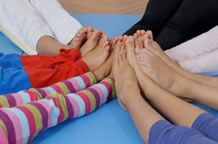 You should always make sure to put in as much effort into taking care of your feet as you do your face. Your toenails should always be trimmed at the proper length in order to avoid getting dirt trapped underneath them. Another tip to maintain healthy feet is to make sure you drink plenty of water. Dehydration can lead to dry and cracked feet. However, if you have cracked heels you should make sure you are scrubbing your feet thoroughly in order to get remove dried skin. Pumice stones are often used to exfoliate the feet and can make your heels soft and smooth.
You should always make sure to put in as much effort into taking care of your feet as you do your face. Your toenails should always be trimmed at the proper length in order to avoid getting dirt trapped underneath them. Another tip to maintain healthy feet is to make sure you drink plenty of water. Dehydration can lead to dry and cracked feet. However, if you have cracked heels you should make sure you are scrubbing your feet thoroughly in order to get remove dried skin. Pumice stones are often used to exfoliate the feet and can make your heels soft and smooth.
Every day foot care is very important to prevent infection and other foot ailments. If you need your feet checked contact Dr. Steven Shlonsky of Kentucky. Dr. Shlonsky can provide the care you need to keep your pain free and on your feet.
Every Day Foot Care
Often, people take care of their bodies, face and hair more so than they do for their feet. But the feet are a very important aspect of our bodies, and one that we should pay more attention to. After all, without our feet, we would not be able to perform most daily tasks. It is best to check your feet regularly to make sure there are no new bruises or cuts that you may not have noticed before, for example.
For dry feet, moisturizer can easily be a remedy and can be applied as often as necessary to the affected areas. Wearing shoes that fit well can also help you maintain good foot health, as well as making it easier to walk and do daily activities without the stress or pain of ill-fitting shoes, high heels, or even flip flops.
Also, wearing clean socks with closed shoes is important to ensure that sweat and bacteria do not accumulate within the shoe. Clean socks help to prevent athlete’s foot, fungi problems, bad odors, and can absorb sweat.
If you have any questions please feel free to contact one of our offices located in Louisville, KY.We offer the newest diagnostic and treatment technologies for all your foot and ankle needs.
High Heels May Negatively Impact Foot Health
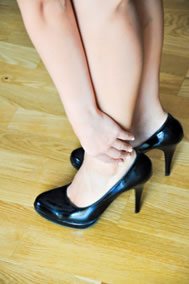 A study published by the Journal of Applied Physiology has determined that long-term high heel use can have detrimental effects on the legs’ muscles, such as muscle strain and muscle fatigue. According to the study’s abstract, long-term high heel use has been found to “shorten medial gastrocnemius muscle fascicles and increase Achilles tendon stiffness.” The study’s results are consistent with reports that high heel wearers often experience discomfort, pain, and tiredness. It also suggests that “long-term high heel use may compromise muscle efficiency in walking”.
A study published by the Journal of Applied Physiology has determined that long-term high heel use can have detrimental effects on the legs’ muscles, such as muscle strain and muscle fatigue. According to the study’s abstract, long-term high heel use has been found to “shorten medial gastrocnemius muscle fascicles and increase Achilles tendon stiffness.” The study’s results are consistent with reports that high heel wearers often experience discomfort, pain, and tiredness. It also suggests that “long-term high heel use may compromise muscle efficiency in walking”.
High heels have a history for causing foot and ankle problems. If you have any concerns about your feet or ankles, contact Dr. Steven Shlonsky of Kentucky. Dr. Shlonsky can provide the care you need to keep your pain free and on your feet.
Effects of High Heels on the Feet
High heels are popular shoes among women because their style and societal appeal. Despite this, they can still cause many health problems if worn too frequently.
What parts my body will be affected by high heels?
- Ankle Joints
- Achilles Tendon – may shorten and stiffen with prolonged wear
- Balls of the Feet
- Knees – heels cause the knees to bend constantly, creating stress on them
- Back – they decrease the spine’s ability to absorb shock, which may lead to back pain. Also, the vertebrae of the lower back may compress.
What kinds of foot problems can develop from wearing high heels?
- Corns
- Calluses
- Hammertoe
- Bunions
- Morton’s Neuroma
- Plantar Fasciitis
How can I still wear high heels and maintain foot health?
If you want to wear high heeled shoes, make sure that you are not wearing them every day, as this will help prevent long term physical problems. Try wearing thicker heels as opposed to stilettos to distribute weight more evenly across the feet. Always make sure you are wearing the proper shoes for the right occasion, such as sneakers for exercising. If you walk to work, try carrying your heels with you and changing into them once you arrive at work. Adding inserts to your heels can help cushion your feet and absorb shock. Full foot inserts or metatarsal pads are available.
If you have any questions please feel free to contact our offices located in Louisville, KY. We offer the newest diagnostic tools and technology to treat your foot and ankle needs.
Effect of High-Heels on the Feet
For hundreds of years, women have been wearing various kinds of high-heels for aesthetic reasons. Women who wear high-heels appear to be taller and have longer and thinner legs, and the wearer’s gait and posture changes. Though high-heels have had an association with femininity and have kept them popular over the years, there are definite health problems caused by wearing them too frequently.
The motion of the ankle joints is limited when heels are worn. The ankle joint is very important to the body when it comes to walking. Because of their location, these joints have a great deal of weight put on them. Thus, it is very important to keep them as healthy as possible. The Achilles tendon is the main tendon in the ankle. Wearing high-heels too often, studies have shown, can cause the calf muscle and Achilles tendon to shorten and stiffen. This can cause problems when shoes without heels are worn.
By putting a great deal of pressure on the ball of the foot and by forcing the toes into a small toe box, high-heels can cause or may worsen many foot problems. These include corns, hammertoe, bunions, Morton’s neuroma and plantar fasciitis.
Not only does wearing very high-heels regularly have negative effects on the feet, the rest of the body can suffer as well. The knees, one of the most important joints in the entire body, can be affected by wearing high-heels. High-heels causes the knees to stay bent all the time. Also, it can cause them to bend slightly inward as well. Doctors believe that women can suffer from osteoarthritis later in life because of constantly walking like in high-heels. By limiting the natural motion of the foot during walking, high-heels also cause an increased in stress on the knees.
Similarly, high-heels can cause the back to go out of alignment. If high-heels are worn constantly, the spine’s ability to absorb shock can cause continued back pain. They can compress the vertebrae of the lower back, and can overuse the back muscles.
However, this is not to say that high-heels can never be worn. If worn occasionally and not often, they will not cause serious problems. They should not be worn every day.It’s important to wear them modestly to avoid the long-term physical health problems of the feet, knees, ankles, and back mentioned above.
Diabetic Foot is a Major Cause of Hospitalization
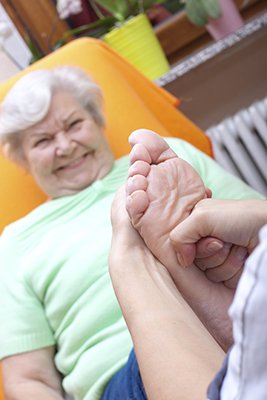 Diabetic foot is one of the top 20 causes of hospitalization in Australia. Studies conducted in the country found that one in every twenty-two patients in Australian hospitals have active diabetic foot disease. The disease is also responsible for over 4,400 amputations and 1,700 deaths each year. Nevertheless, early prevention is the best way to assure that diabetic foot does not progress into something much worse. It is recommended that every diabetic who goes to a hospital asks to have their foot screened for diabetic foot. Many people who have the disease often aren’t aware of it.
Diabetic foot is one of the top 20 causes of hospitalization in Australia. Studies conducted in the country found that one in every twenty-two patients in Australian hospitals have active diabetic foot disease. The disease is also responsible for over 4,400 amputations and 1,700 deaths each year. Nevertheless, early prevention is the best way to assure that diabetic foot does not progress into something much worse. It is recommended that every diabetic who goes to a hospital asks to have their foot screened for diabetic foot. Many people who have the disease often aren’t aware of it.
Diabetic foot care is important in preventing foot ailments such as ulcers. If you are suffering from diabetes or have any other concerns about your feet contact Dr. Steven Shlonsky of Kentucky. Dr. Shlonsky can provide the care you need to keep your pain free and on your feet.
Diabetic Foot Care
Diabetes affects millions of people every year. Diabetes can damage blood vessels in many parts of the body, including the feet. Because of this, taking care of your feet is essential if you have diabetes, and having a podiatrist help monitor your foot health is highly recommended.
The Importance of Caring for Your Feet
- Routinely inspect your feet for bruises or sores.
- Wear socks that fit your feet comfortably.
- Wear comfortable shoes that provide adequate support.
Patients with diabetes should have their doctor monitor their blood levels because blood sugar levels play such a huge role in diabetic care. Monitoring these levels on a regular basis is highly advised.
It is always best to inform your healthcare professional of any concerns you may have regarding your feet, especially for diabetic patients. Early treatment and routine foot examinations are keys to maintaining proper health, especially because severe complications can arise if proper treatment is not applied.
If you have any questions please feel free to contact one of our offices located in Louisville, KY. We offer the newest diagnostic and treatment technologies for all your foot and ankle needs.
Read more about Diabetic Foot Care
Caring for Blisters
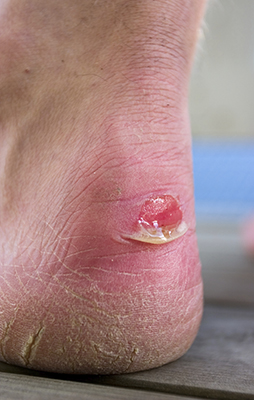 Blisters are a fairly common foot condition that can be easily prevented with a few simple steps. The first step is to always ensure the feet or kept clean to prevent any germs or bacteria from penetrating the skin. Wearing the right pair of socks can also help support the feet and reduce friction, which can create blisters. Applying bandages or band aids to any already existing blisters can help reduce excess heat or additional friction that can exacerbate the blister.
Blisters are a fairly common foot condition that can be easily prevented with a few simple steps. The first step is to always ensure the feet or kept clean to prevent any germs or bacteria from penetrating the skin. Wearing the right pair of socks can also help support the feet and reduce friction, which can create blisters. Applying bandages or band aids to any already existing blisters can help reduce excess heat or additional friction that can exacerbate the blister.
Blisters are prone to making everyday activities extremely uncomfortable. If your feet are hurting, contact Dr. Steven Shlonsky of Kentucky. Dr. Shlonsky will assist you with all of your podiatric concerns.
Foot Blisters
Foot blisters develop as a result of constantly wearing tight or ill-fitting footwear. This happens due to the constant rubbing from the shoe, which can often lead to pain.
What are Foot Blisters?
A foot blister is a small fluid-filled pocket that forms on the upper-most layer of the skin. Blisters are filled with clear fluid and can lead to blood drainage or pus if the area becomes infected.
How do Blisters Form?
Blisters on the feet are often the result of constant friction of skin and material, usually by shoe rubbing. Walking in sandals, boots, or shoes that don’t fit properly for long periods of time can result in a blister. Having consistent foot moisture and humidity can easily lead to blister formation.
Prevention & Treatment
It is important to properly care for the affected area in order to prevent infection and ease the pain. Do not lance the blister and use a Band-Aid to provide pain relief. Also, be sure to keep your feet dry and wear proper fitting shoes. If you see blood or pus in a blister, seek assistance from a podiatrist.
If you have any questions please contact our offices located in Louisville, KY. We offer the newest diagnostic and treatment technologies for all your foot and ankle needs.
Read more about blisters on the feet
Ways to Treat Bunions
 Hallux valgus, which is more commonly known as a bunion, is a deformity of the joint at the base of the big toe. Most people who have bunions develop them from wearing uncomfortable shoes for a long period of time. Women are more likely to have bunions compared to men because they often wear high heels. Bunions are not a life threatening condition; however they can negatively impact one’s quality of life. There are a few non-surgical options for those wishing to treat their bunions. Physiotherapy and the use of devices such as bunion splints and toe spacers can work to alleviate bunion pain; however they may not be effective in the long run.
Hallux valgus, which is more commonly known as a bunion, is a deformity of the joint at the base of the big toe. Most people who have bunions develop them from wearing uncomfortable shoes for a long period of time. Women are more likely to have bunions compared to men because they often wear high heels. Bunions are not a life threatening condition; however they can negatively impact one’s quality of life. There are a few non-surgical options for those wishing to treat their bunions. Physiotherapy and the use of devices such as bunion splints and toe spacers can work to alleviate bunion pain; however they may not be effective in the long run.
Bunion surgery usually occurs after non-surgical methods have proved to be ineffective. If you have any concerns, contact Dr. Steven Shlonsky of Kentucky. Dr. Shlonsky will assess your injury and provide you with quality treatment.
What is a Bunion?
A bunion is formed of swollen tissue or an enlargement of boney growth, usually located at the base joint of the toe that connects to the foot. The swelling occurs by the bones in the big toe shifting inward, which impacts the other toes of the foot. This causes the area around the base of the big toe to become inflamed and painful.
Why do Bunions Form?
- Genetics – susceptibility to bunions are often hereditary
- Stress on the feet – poorly fitted and uncomfortable footwear that places stress on feet, such as heels, can cause bunions to form
How are Bunions Diagnosed?
Doctors often perform two tests – blood tests and x-rays – when trying to diagnose bunions, especially in the early stages of development. Blood tests help determine if the foot pain is being caused by something else, such as arthritis, while x-rays provide a clear picture of your bone structure to your doctor.
How are Bunions Treated?
- Refrain from wearing heels or similar shoes that cause discomfort
- Select wider shoes that can provide more comfort and reduce pain
- Anti-inflammatory and pain management drugs
- Orthotics or foot inserts
- Surgery
If you have any questions, please feel free to contact our office located in Louisville, KY. We offer the newest diagnostic and treatment technologies for all your foot care needs.
Read more about bunions.







